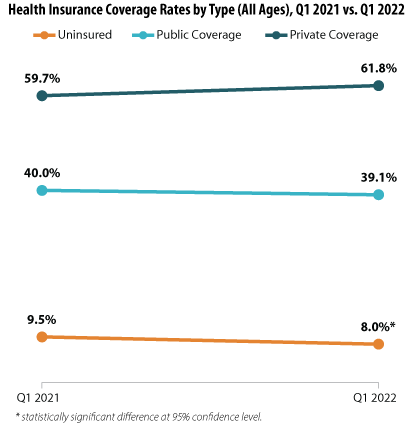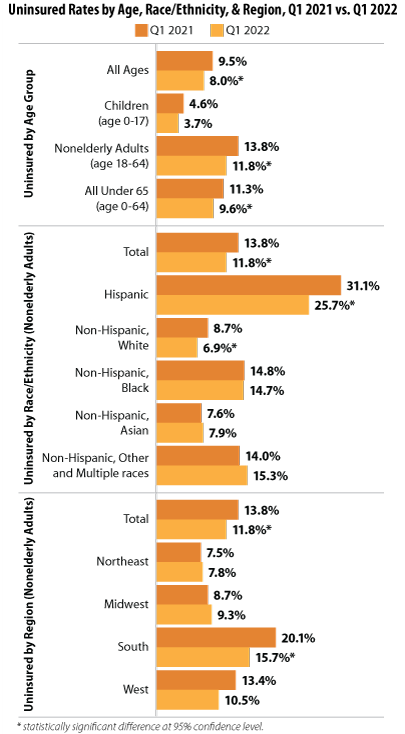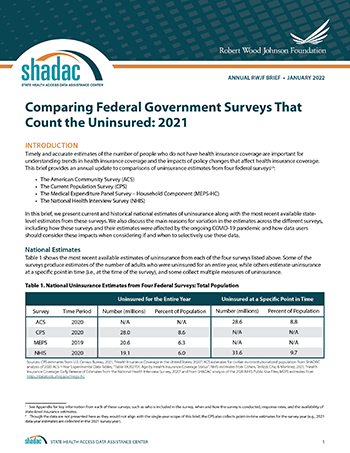Blog & News
2022 NHIS Early Release: Estimates from Quarter 1 (January-March) show potential post-pandemic rebounds in health insurance coverage
August 8, 2022:The National Center for Health Statistics (NCHS) has released quarterly estimates of health insurance coverage beginning in January 2021 through March 2022 from the National Health Interview Survey (NHIS) as part of the NHIS Early Release Program.
After disruptions to data collection operations due to COVID-19 in 2020 and 2021, NHIS quarterly estimates for 2022 were able to collect and produced as usual.1 Estimates for each included category of insurance coverage (uninsured, public, and private) have been disaggregated by age group and family incomes as a percentage of the federal poverty level (FPL), reported race and ethnicity categories, and by geographic region.2
Uninsured rate saw significant decreases while public and private coverage remain stable
As the United States emerges from the height of the COVID-19 pandemic, estimates from the NHIS indicate positive trends for health insurance rates across coverage types thus far in 2022.
The uninsured rate dropped significantly across all age groups, decreasing by an incredible 1.5 percentage points (PP) from 9.5% during Q1 2021 to a historic low of just 8.0% during Q1 2022.
While public and private insurance coverage rates showed no statistically significant changes between the Quarter 1 time periods (measuring at 40.0% in 2021 and 39.1% in 2022 and 59.7% in 2021 and 61.8% in 2022, respectively), the potential shifts in coverage that are hinted at by the NHIS data offer hope toward a continuing post-pandemic recovery. A possible rise in private insurance coverage would indicate the potential for a resurgence in employer-sponsored insurance (ESI) due to a prospective rise in employment (unemployment rates fell sharply to 5.3% in 2021 from 8.1% in 2020).3 Consequently, this potential rise in private insurance coverage appears to be possibly offset by a reduction in public insurance coverage, indicating a consequent reduction in the portion of the national population needing to rely on safety net public insurance programs such as Medicaid. Again, our analysis of the NHIS insurance estimates did not find the year-to-year changes in public and private coverage to be statistically significant; therefore, these data will require further monitoring to see if these possible trends bear out.
Falling uninsured rates across demographic groups
Examining the NHIS coverage estimates for Q1 (January-March) 2022 revealed further good news in that a number of demographic subgroups saw a significant reduction in uninsured rates: by age, by race and ethnicity, and by geographic region.
Findings by age group
Our analysis showed not only a significant drop in uninsurance across all age groups from 2021 to 2022 (9.5% to 8.0%, respectively), but this decrease was underscored by rates for individuals under 65 (11.3% to 9.6%) and for nonelderly adults age 18-64 (13.8% to 11.8%). Rates for children (age 0-17) remained stable between the two years’ first quarters.
Findings by race and ethnicity
Uninsured rates also decreased significantly for Hispanic nonelderly adults (age 18-64)—dropping from 31.1% in Q1 2021 to 25.7% in Q1 2022—and for Non-Hispanic, White nonelderly adults (age 18-64) —dropping from 8.7% in Q1 2021 to 6.9% in Q1 2022.
Findings by geographic region
While uninsured rates in most regions remained stable between January-March of 2021 and 2022, NHIS data showed a significant drop in uninsurance for nonelderly adults (age 18-64) in the South, a region that traditionally has seen higher rates of uninsurance, falling to 15.7% in 2022 from 20.1% in 2021.4
Overall, data from Q1 of 2022 indicated positive trends in health insurance coverage, with uninsured rates falling significantly for a number of population subgroups and a potential (though not significant) recovery for private insurance and a lessening of public insurance coverage.
About the Numbers
The above estimates provide a point-in-time measure of health insurance coverage, indicating the percent of individuals with (or without) a specific type of coverage at the time of the interview. The estimates discussed in this blog are only from Q1 (January-March) 2022 and the same period in 2021.
Differences in estimates are statistically significant at the 95% confidence level unless otherwise specified.
Notes
1 SHADAC has previously documented the ways that data collection efforts for the NHIS, as well as a number of other federal surveys, were impacted in 2020 due to the COVID-19 pandemic. Additionally, NCHS—the organization which conducts the NHIS—has provided additional detail on the ways that COVID impacted collection in 2021 to a lesser degree. From January through April 2021, NHIS interviews continued to be attempted by telephone first, with personal visits used only to follow-up on nonresponse, deliver recruitment materials, and conduct interviews when telephone numbers were unknown. Starting in May, field representatives were given discretion to decide whether or not to resume personal visits based on their own health risk and the conditions in the area.
2 FPL categories have been further stratified than in previous years. Through 2020, poverty level estimates were classified in categories of “poor,” “near poor,” and “not poor,” which corresponded with 2021 classifications of “<100% FPL,” “100% to less than 200% FPL,” and “200% and greater FPL.” In the 2022 estimates, the categories were expanded to include a “200% to less than 400% FPL” category and a “400% and greater FPL.”
3 SHADAC analysis of Bureau of Labor Statistics data for 2020 and 2021. State Health Compare. Unemployment rate: 2020; 2021 [Data set]. State Health Access Data Assistance Center. http://statehealthcompare.shadac.org/trend/148/unemployment-rate-by-total#0/1/a/19,20,9,10,11,12,13,14,1,2,3,4,5,6,7,8,15,24,25,27,32,37/185
4 Tolbert, J. & Orgera, K. (2020, November 6). Key facts about the uninsured population. Kaiser Family Foundation (KFF). https://www.kff.org/uninsured/issue-brief/key-facts-about-the-uninsured-population/
Office of Health Policy. (2021, March 23). The remaining uninsured: Geographic and demographic variation [No. HP-2021-06]. Office of the Assistant Secretary for Planning and Evaluation (ASPE). https://aspe.hhs.gov/sites/default/files/private/pdf/265286/Uninsured-Population-Issue-Brief.pdf
NHIS Report Citation
Cohen, R.A. & Cha, A.E. (July 2022). Health insurance coverage: Early release or quarterly estimates from the National Health Interview Survey, January 2021–March 2022. National Center for Health Statistics (NCHS). https://www.cdc.gov/nchs/data/nhis/earlyrelease/Quarterly_Estimates_2022_Q11.pdf
Blog & News
Now Available on State Health Compare: Five Updated Measures and One Brand New Measure
July 27, 2022:Estimates for five measures of health care access, affordability, and use have now been updated on SHADAC’s State Health Compare web tool. One new measure, Had Dental Visit has also been added to the tool. The new and updated measures are all produced using data from the National Health Interview Survey (NHIS), conducted by the National Center for Health Statistics (NCHS). SHADAC produces these state-level measures using restricted-access data through the Minnesota Research Data Center (MnRDC). SHADAC’s State Health Compare is the only source of state-specific data for these measures which are essential for monitoring individuals’ access to and use of medical care, along with their ability to afford care.
These measures now contain data updated through 2020, using two-year pooled periods (i.e., 2017-2018, 2019-2020). The measures can be broken down by Total, Age, and Coverage Type (Public, Private, Uninsured). Additional breakdowns—such as Race and Ethnicity—will be highlighted within future SHADAC blogs as they become available.
Updated and new measures include:
![]()
 NEW: Had Dental Visit
NEW: Had Dental Visit
This measure describes the percent of individuals who had a dental examination or cleaning during the past twelve months.

Had Usual Source of Medical Care
This measure captures rates of individuals who had a usual place of medical care other than an emergency department during the past twelve months.
 Had General Doctor or Provider Visit
Had General Doctor or Provider VisitThis measure provides rates of individuals who had any visit to a general doctor or provider within the last year.
 Had Emergency Department Visit
Had Emergency Department VisitThis measure looks at rates of individuals who had any type of visit to an emergency department in the past twelve months.
 Trouble Paying Medical Bills
Trouble Paying Medical BillsThis measure examines rates of individuals who had trouble paying off medical bills during past twelve months for the civilian non-institutionalized population.
 Made Changes to Medical Drugs
Made Changes to Medical DrugsThis measure highlights rates of individuals who were prescribed medication in the past twelve months who made changes to medical drugs because of cost during the past twelve months for the civilian non-institutionalized population. This includes delaying filling a prescription, taking less medicine, or skipping medication doses to save money.
Click here to explore these measures on State Health Compare!
Data Sources
The estimates were produced using restricted NHIS data in the MnRDC. Measures have been updated with data through 2020 using two-year pooled periods, including (a) 2017-2018 and (b) 2019-2020.
Blog & News
2021 NHIS Full-Year Health Insurance Estimates Early Release: Coverage Rates Remain Stable Overall, Changes Visible across Demographic Groups (Infographic)
May 10, 2022:The National Center for Health Statistics (NCHS) released health insurance coverage estimates for 2021 from the National Health Interview Survey (NHIS) as part of the NHIS Early Release Program. The estimates captured in this report are some of the first available coverage estimates for 2021 from a federal survey.
National-level estimates are available by breakdowns including age, sex, poverty status, race and ethnicity, and by state Medicaid expansion status. The NHIS full-year estimates for 2021 do not include either full or partial state-level data, as has been the case since the survey was redesigned in 2019. However, NCHS periodically releases state-level estimates of coverage, which SHADAC has previously covered on our blog and will continue to monitor and report on any future releases.
Changes between the 2020 and 2021 coverage estimates were minimal when examining rates of private coverage and those without health insurance coverage. However, the 2021 report indicates a slight uptick in public coverage which is consistent with trends in survey and administrative data since the start of the coronavirus (COVID-19) pandemic in the United States. The rates across all coverage types experienced several more notable shifts when examined by sex as well as race and ethnicity.
Changes in the NHIS
The COVID-19 pandemic significantly impacted 2020 NHIS field procedures (including interview format), response rates, and resulting data analytic files, though NCHS found minimal nonresponse bias in the 2020 NHIS. A recent SHADAC issue brief reported on these and other changes to federal surveys that were similarly impacted by the pandemic.
It is also worth noting that 2021 NHIS coverage estimates are based on information collected from 29,696 sample adults and 8,293 sample children. In 2019, the NHIS underwent a substantial redesign of its content and structure and one of the largest changes, the elimination of the family questionnaire, has resulted in a substantial reduction of the available sample size for the survey (though the NCHS also estimates a positive effect on higher response rates). It is likely that a survey with a larger sample size would find more significant year-over-year changes in coverage rates.
Notes on Race and Ethnicity Estimates from NHIS
The NHIS Early Release report from which the figures for the race/ethnicity category are drawn does not further disaggregate statistics by more detailed race and ethnicity categories. Individuals not identifying as Hispanic; non-Hispanic White, Black, or Asian; or identifying with multiple, non-Hispanic race categories are classified as “multiple races or any other race.”
Additionally, there are many factors that historically widen disparities in coverage across race and ethnicity; race-based discrimination in employment and systemic racism are two possible contributors.
Other NHIS analyses from 2022
- 2022 NHIS Early Release: Estimates for First Half of the Year Show Continued Fall of Uninsured Rates (Blog) December 2022
- 2022 NHIS Early Release: Quarter 1 estimates show potential post-pandemic rebounds (Blog) August 2022
- NHIS: National Rates of Health Insurance Coverage for Third Quarter of 2021 Statistically Unchanged from 2020 (Blog) January 2022
Source
Cohen, R.A., Cha, A.E., Terlizzi, E.P., & Martinez, M.E. (2022, May 5). Health insurance coverage: Early release of estimates from the National Health Interview Survey, 2021. National Center for Health Statistics (NCHS). https://www.cdc.gov/nchs/data/nhis/earlyrelease/insur202205.pdf
Publication
Comparing Federal Government Surveys That Count the Uninsured: 2021
With the release of new insurance coverage estimates from surveys conducted by the U.S. Census Bureau, the Agency for Healthcare Research and Quality (AHRQ), and the Centers for Disease Control and Prevention (CDC), SHADAC has updated our annual “Comparing Federal Government Surveys that Count the Uninsured” brief.
The brief provides an annual update to comparisons of uninsurance estimates from four federal surveys:
- The American Community Survey (ACS)
- The Current Population Survey (CPS)
- The Medical Expenditure Panel Survey - Household Component (MEPS-HC)
- The National Health Interview Survey (NHIS)
In this brief, SHADAC presents current and historical national estimates of uninsurance along with the most recent available state-level estimates from these surveys (where possible). We also discuss the main reasons for variation in the estimates across the different surveys as well as possible reasons for incomparability of estimates across and within the surveys.
Due to the substantial impacts of the COVID-19 pandemic on federal survey data collection and production, this year the brief also includes a brief overview of the unique challenges faced by each agency conducting the four surveys due to pandemic-related disruptions, how the agencies addressed and compensated for these challenges, and what these impacts mean in terms of utilizing survey data on health insurance coverage for 2020.
Download a PDF of the Comparing Federal Government Surveys Brief.
Last year’s brief with data from the 2020 collection year, and certain 2019 collection-year data, can be accessed here.
Blog & News
NHIS: National Rates of Health Insurance Coverage for Third Quarter of 2021 Statistically Unchanged from 2020
January 25, 2022:On Wednesday, January 19, the National Center for Health Statistics (NCHS) announced that health insurance coverage estimates from the National Health Interview Survey (NHIS) Early Release Program are now available for Quarter 3 of 2021 (July-September)
At a high level, the new estimates show no significant changes in coverage type (public, private) or uninsured rate across all ages and income groups when compared to the same time period in 2020, as discussed below.
Age
Among nonelderly adults (ages 18 to 64) surveyed between July and September of 2021, 13.0% were uninsured at the time of interview, 21.1% had public coverage, and 67.3% had private coverage. Comparatively, these rates measured at 14.1%, 20.3%, and 67.4% from July to September in 2020, as shown in Figure 1.
Figure 1. Type of Health Insurance Coverage Nonelderly Adults (18-64 years), Q3 2020 and Q3 2021
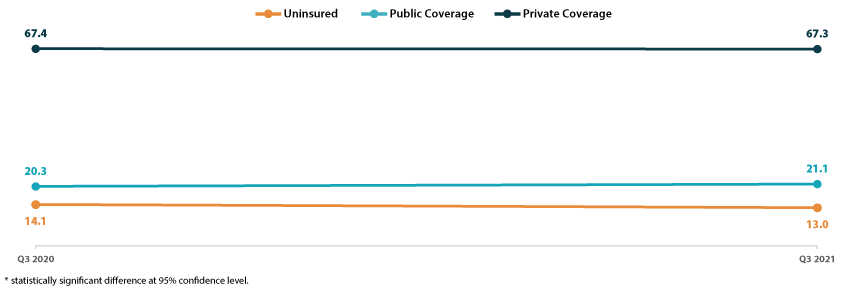
Poverty Level
Again among nonelderly adults at three differing thresholds of family income as a percentage of the federal poverty level (less than 100% FPL, 100%-199% FPL, and 200%+ FPL), rates of uninsurance as well as public and private coverage remained statistically unchanged in Q3 2021 from Q3 2020.
Looking at the below than 100% FPL category for nonelderly adults from July-September 2021, 21.7% were uninsured, 52.3% had public coverage, and 27.2% had private coverage. These rates were 28.6%, 51.3%, and 22.3%, respectively in 2020 (Figure 2).
Figure 2. Type of Health Insurance Coverage (<100% FPL) Nonelderly Adults (18-64 years), Q3 2020 and Q3 2021
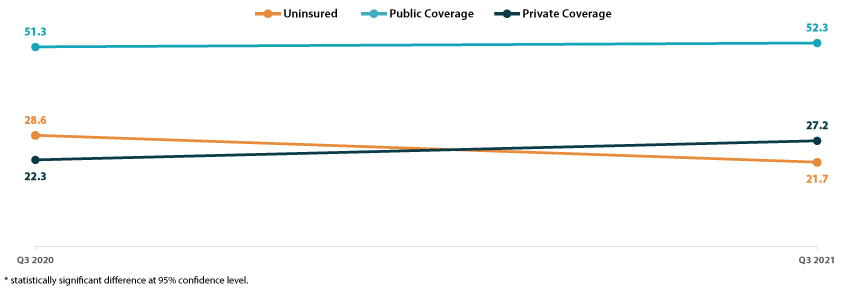
COVID-19 and Cautions for 2020 NHIS Estimates
As has been extensively documented in reports from both SHADAC and NCHS, COVID-19 caused numerous disruptions to federal survey data collection and production efforts. For the NHIS in particular, personal visits were suspended beginning on March 19, 2020, and data collection in late Q1 and for all of Q2 in 2020 switched to a telephone-only mode. Personal visits (with telephone attempts first) resumed in all areas in September 2020.
Data collection methodologies were not the only casualty of the pandemic, however. While the initial NCHS report examined preliminary nonresponse bias in Q1 and Q2 of 2020, the same team published a follow-up report in September 2021 looking at effects of the pandemic on estimates for the entire year, including July to December 2020. Though in-person operations resumed, lingering concerns about low response rates and possible loss of coverage caused survey conductors to replace approximately half of the usual sample for the last 5 months of 2020 with a longitudinal component where a subset of the 2019 sample adults were re-interviewed over the telephone using the 2020 NHIS questionnaire. This process change means that comparisons between estimates from July–December 2020 and other time periods may be impacted by these differences in survey mode and methodology.
About the Numbers
The above estimates provide a point-in-time measure of health insurance coverage, indicating the percent of persons with that type of coverage at the time of the interview. The 2021 estimates discussed in this blog are only from Q3 (July-September) as well as the same period in 2020.
Differences described in this post are statistically significant at the 95% confidence level unless otherwise specified.
Citations
Cohen, R.A. & Cha, A.E. (2022, January 19). Health Insurance Coverage: Early Release of Quarterly Estimates from the National Health Interview Survey, July 2020–September 2021. National Center for Health Statistics (NCHS). https://www.cdc.gov/nchs/data/nhis/earlyrelease/Insur201902.pdf.
Dahlhamer, J.M., Bramlett, M.D., Maitland, A., & Blumberg, S.J. (February 2021). Preliminary evaluation of nonresponse bias due to the COVID-19 pandemic on National Health Interview Survey estimates, April-June 2020. National Center for Health Statistics (NCHS). https://www.cdc.gov/nchs/data/nhis/earlyrelease/nonresponse202102-508.pdf
Bramlett, M.D., Dahlhamer, J.M., & Bose, J. (September 2021). Weighting procedures and bias assessment for the 2020 National Health Interview Survey. National Center for Health Statistics (NCHS). https://ftp.cdc.gov/pub/Health_Statistics/NCHS/Dataset_Documentation/NHIS/2020/nonresponse-report-508.pdf








